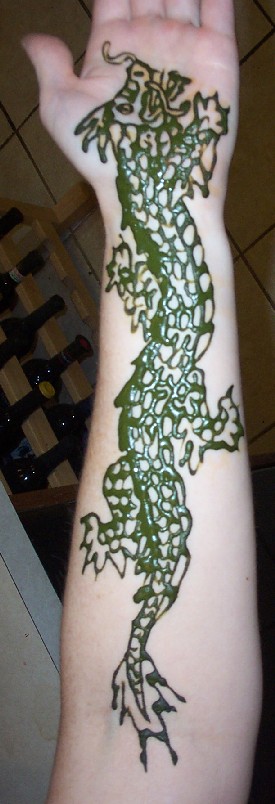
I was experimenting with a new recipe tonight and wanted to test it out on my arm. My first problem was that the goop was too thin, so I had to add more powder. I worried that the henna had indigo in it again, because it was bright green, but it didn’t. It’s just fresh.
I don’t think this design will turn out very dark. I had to scrape it off after an hour because my skin was itching. I thought maybe it was lemon juice in tiny cuts, but it was hurting all over, not just in one or two places. The culprit is the mustard seed oil. They didn’t have eucalyptus oil for sale at the Indian Grocery, and I didn’t want to think that I drove five miles out of my way for nothing, so I got mustard oil. I’ve heard it’s a good mordant for henna, but that it can be harsh on the skin. They got that right. Next time I’ll stick with olive oil.

4 comments
Skip to comment form
I recently purchased a Henna kit. When I opened the kit, the bottle of Mordant had leaked and was empty. Do you have a suggestion of what I could use as a replacement?
Thanks
Author
Make really strong black tea, and when you steep it, add cardamon. Mix lemon juice in too, as the acid will help.
I’ve heard using mehaiba oil or clove oil or mustard oil with the henna mix helps fix it, but these are expensive and in some cases they react poorly with the skin. I use olive oil, because I like the way it smells (and I like the consistency it gives the oil) and because it’s cheap and available.
A more accurate recipe is in Mehindi: The Timeless Art of Henna Painting, by Loretta Roome.
Do not use mehaiba, clove, or mustard oil in you henna. They are all very irritating, the mehaiba has unknown and often useless ingredients, and mustard oil can impede the stain.
You want essential oils that are high in monoterpene alcohols, such as tea tree, lavender (aromatherapy grade), ravensara, clove BUD (much more gentle that clove), cajeput, and geranium…to name a few. They break down the cellulose in the plant and make more dye available.
This is my henna recipe and I get fabulous results every time:
1/4 cup henna powder
1/4 cup lemon juice (fresh or bottled)
Mix well, cover with plastic wrap and let sit in a warm place for 12 hours
Add 1 TBSP artificial sweetner (to help it stay on the skin longer)
1 TBSP essential oils (tea tree works well, is inexpensive and readily available)
Mix well, cover and let sit another 12-18 hours
Check consistency, if it’s too thick add a bit more lemon juice. Put in cone or jac bottle and off you go.
Author
The problem with all of these essential oils is that they are very expensive, and hard to find. I do like the idea of using just lemon juice and henna powder, as I nearly always have fresh lemon juice available (we have a tree.)
It seems that there are as many henna recipies as there are practitioners. I’ve never had any recipe do well on my skin or hair–they always fade quickly–but other people have had satisfactory results with the same formula.
Thanks for the comment!